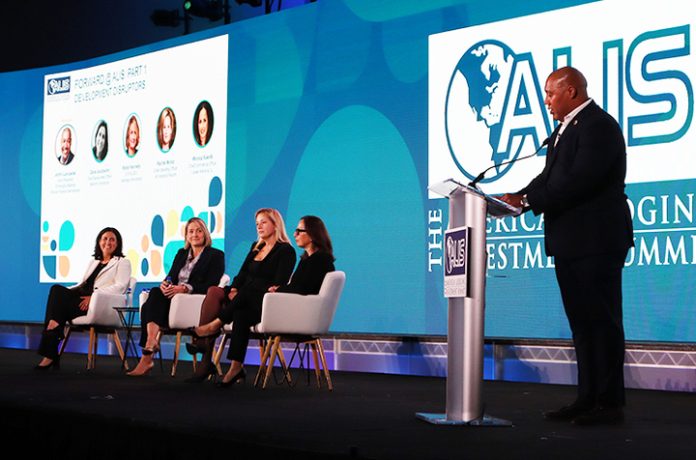LODGING is live from ALIS 2024, brought to you by Choice Hotels. Access more of our live coverage here.
Remote work, longer stays, wellness and the demand for cutting-edge technology were among the top consumer trends cited by a quartet of female development executives as driving both demand and design within the newest generation of hotels.
In a panel entitled “Forward @ ALIS: Part 1 – Development Disruptors”—which was moderated by John Lancaster, VP, emerging markets, Choice Hotels International—the panelists also detailed some of the latest development trends.
Dana Jacobsohn, Chief Development Officer, Marriott International, explained specifically how the post-COVID job market dynamics have impacted the lodging landscape.
“What’s remarkable to me is remote work and how it has completely influenced the customer and therefore changed the hospitality industry. Folks who can work remotely now are traveling more [and creating] that bleisure demand, which is therefore resulting in long-term or extended stays,” she said.
That trend has also resulted in lots of new extended-stay product, such as Marriott’s StudioRes brand, which recently broke ground on its first property in Fort Myers, FL, a little more than six months after initially being rolled out.
Jacobsohn elaborated on the core tenets of the midscale extended-stay brand.
“It’s got an efficient business model with low staffing and high occupancy; it’s something that the developers were asking for. The [target] customer is traveling nurses; construction workers who are on assignment; government workers who are working on the infrastructure bill; or anyone who needs to find an affordable place to work remotely,” she said.
Jacobsohn further characterized the length of stay evolution as a global hospitality trend that the company is leveraging with a range of extended-stay offerings.
“What we’ve seen is this desire for customers to stay for a very long time, it’s global. So this is happening all over the world for Marriott international,” she noted.
For her part, Robin Kennedy, EVP & CDO, Montage International, acknowledged the length of stay shift within the luxury segment as well.
“The customer broadly is changing those longer-term stays. The luxury guest is untethered more than most and so they are able to go anywhere at any time. It changes the patterns and how they see the stays, but it also changes how they’re experiencing their stay,” she commented.
Kennedy elaborated on what’s important to today’s luxury guest.
“They’re looking for those moments to also turn off and to disconnect and so wellness is a very big part of what we’re really starting to see as a focus of the resorts. It’s not only the spa stays, but it’s how they’re experiencing recreation, as well as how they’re getting out into the environment and finding those moments. If you’re programming your hotel and thinking about how you’re providing those experiences the guest will continue to come back,” she maintained.
Monica Xuereb, Chief Commercial Officer, Loews Hotels & Co., meanwhile, talked about how the luxury brand manager has shaped the guest experience when it comes to F&B, particularly with regards to sourcing product locally.
“We are able to bring this approach to all of our F&B outlets, it’s not just in one restaurant or in one menu. This kind of biodynamic [sustainable sourcing] approach is really in every F&B outlet in the hotel, whether that’s banquets, the Grab and Go, or the coffee shop. Because we’re an owner/operator we can say that it’s really a standard across all of our hotels and I think our guests really appreciate that,” she stated.
Finally, Rachel Moniz, COO, HEI Hotels & Resorts, emphasized the role of technology in hospitality while cautioning about some of the potential pitfalls as well.
“I think technology is really important to the customers. This industry is a little slow when it comes to technology, but then there’s also the risk of the shiny new toy that everyone buys and then convinces our owners to spend tens of thousands [dollars] on and it doesn’t get used properly. So I think it’s a balance,” she said.
Moniz further elaborated.
“I certainly think that if we’re going to appeal to the next generation—and we’re now seeing they’re starting to spend money—then we’re going to need to invest in technology that’s meaningful to our customer. I think it’s a matter of figuring out what’s important to that particular customer and delivering on it. I think it’s also equally important to cut out the things that aren’t necessarily important to them,” she concluded.













